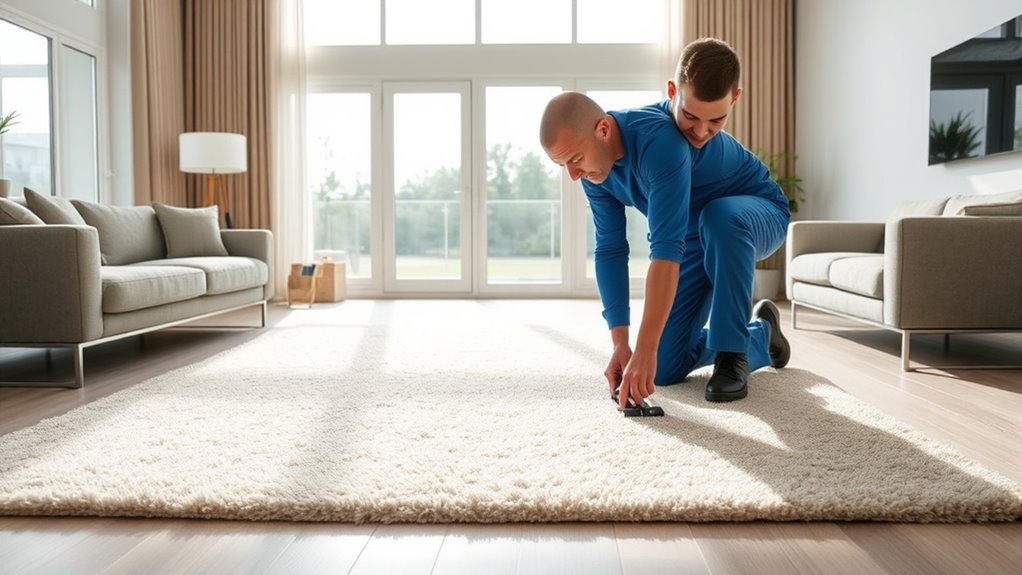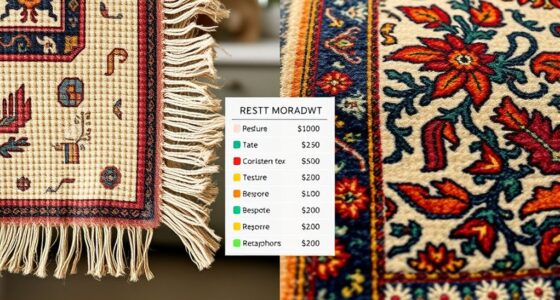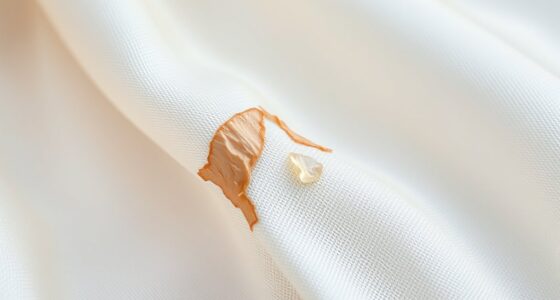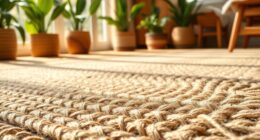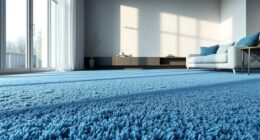If you notice ripples, wrinkles, or edges lifting, it’s time to stretch your rug. Over time, foot traffic, wear, and improper installation can cause looseness and unevenness. Regularly maintaining and stretching your rug helps it look smooth, lasts longer, and prevents damage. How often depends on traffic and conditions, but knowing the signs guarantees you keep your rug in top shape. Keep going, and you’ll discover effective techniques and when to call in professionals.
Key Takeaways
- Rug stretching is needed when wrinkles, ripples, or buckling appear, often due to improper installation or foot traffic.
- Regular stretching helps prevent damage, extend the rug’s lifespan, and maintain a smooth, attractive appearance.
- Signs like edges curling, uneven surfaces, or stubborn creases indicate it’s time for stretching.
- High-traffic areas or changes in humidity can accelerate the need for periodic stretching.
- Professional stretching is recommended for delicate or heavily wrinkled rugs to ensure safety and quality results.
Signs That Indicate Your Rug Needs Stretching
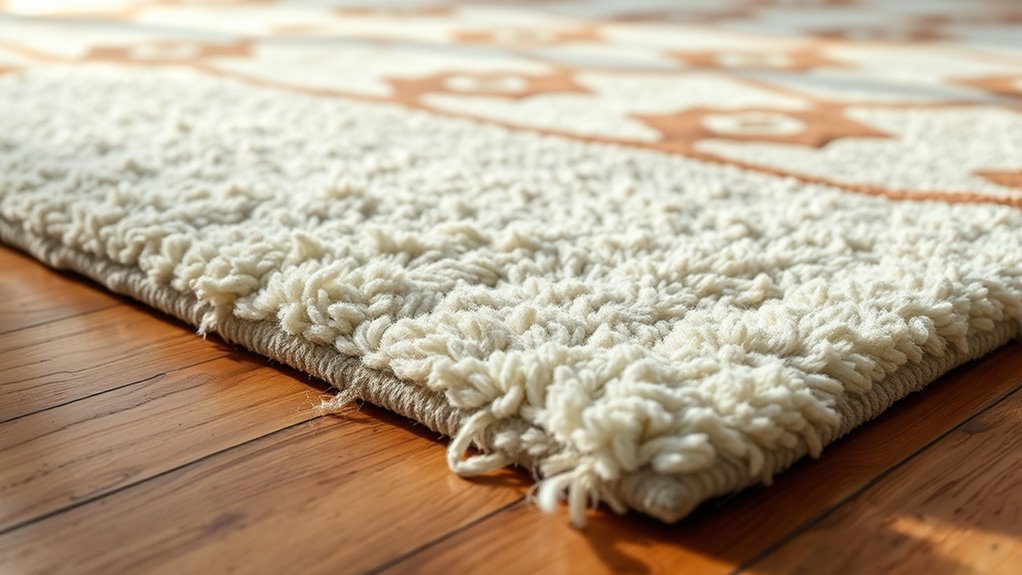
If your rug is starting to ripple or develop wrinkles, it’s a clear sign that it needs stretching. You might notice the edges lifting or the surface appearing uneven, especially after cleaning or moving furniture. These ripples can become more prominent over time, making the rug look untidy and potentially causing tripping hazards. When the backing or fibers loosen, the rug no longer lays flat, which affects its appearance and safety. Additionally, if you see creases that don’t smooth out easily, that’s a strong indication it’s time to act. Ignoring these signs can lead to further damage, including fraying or tearing. Recognizing these visual cues early helps maintain your rug’s integrity and keeps your space looking neat. Proper rug stretching techniques can help restore its original look and prolong its lifespan.
The Benefits of Regular Rug Maintenance

Regular rug maintenance helps your rug last longer and stay looking its best. When you keep up with cleaning and stretching, you prevent damage and wear over time. This simple effort saves you money and keeps your space looking fresh. Regularly inspecting and addressing areas that may need stretching or repair can further extend the life of your rug.
Extends Rug Lifespan
Maintaining your rug regularly can considerably extend its lifespan, saving you money and effort in the long run. When you routinely clean and inspect your rug, you prevent dirt, debris, and moisture from causing damage over time. Regular maintenance helps identify early signs of wear, such as fraying or loose fibers, allowing you to address issues before they worsen. Proper stretching and cleaning preserve the rug’s fibers, preventing uneven wear and fiber breakdown. Additionally, keeping your rug free from pests and mold reduces deterioration. By staying proactive with maintenance, you reduce the need for costly replacements and repairs. Being aware of regional legal resources and understanding the importance of proper care can further protect your investment. Ultimately, consistent care ensures your rug remains durable and functional for years, making your investment in quality flooring more worthwhile.
Maintains Appearance Quality
Consistently caring for your rug keeps its colors vibrant and patterns sharp, ensuring it looks fresh and inviting. Regular maintenance prevents dirt and debris from dulling its appearance. When you schedule routine cleaning and stretching, you preserve the rug’s original design. Here are three ways maintenance enhances appearance quality: 1. Restores the rug’s shape, preventing unsightly wrinkles and bunching. 2. Keeps fibers aligned, maintaining smoothness and uniformity. 3. Protects vivid dyes from fading, ensuring colors stay bold over time. Additionally, proper stretching can prevent premature wear caused by fiber distortion and improve the overall durability of your rug.
How Often Should You Stretch Your Rug?
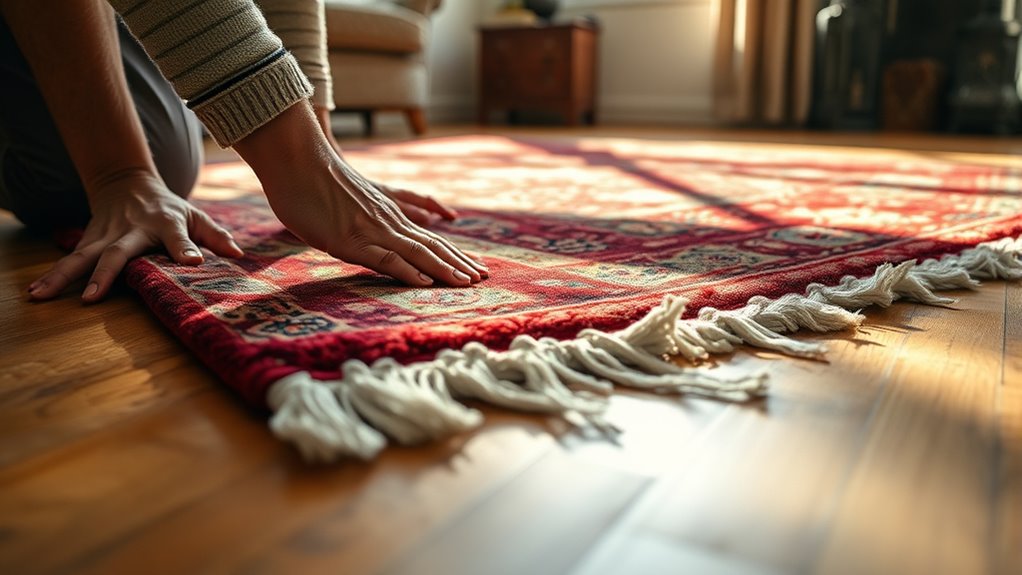
You should stretch your rug whenever you notice it starting to lift or develop wrinkles, typically every 6 to 12 months. Regular stretching helps maintain a smooth appearance and prevents further damage. The frequency depends on foot traffic, humidity, and rug material. For high-traffic areas, you might need to stretch it more often. Use this guideline to determine your schedule:
| Rug Condition | Recommended Stretching Frequency |
|---|---|
| Wrinkles or lifting | Every 6 months |
| Minimal wear | Annually |
| Heavy traffic | Every 4-6 months |
Consistent maintenance keeps your rug looking fresh and extends its lifespan. Pay attention to signs of slackening, and don’t wait too long before stretching again. Regular maintenance supports a healthy rug environment and prevents premature wear.
Techniques and Tools for Effective Rug Stretching
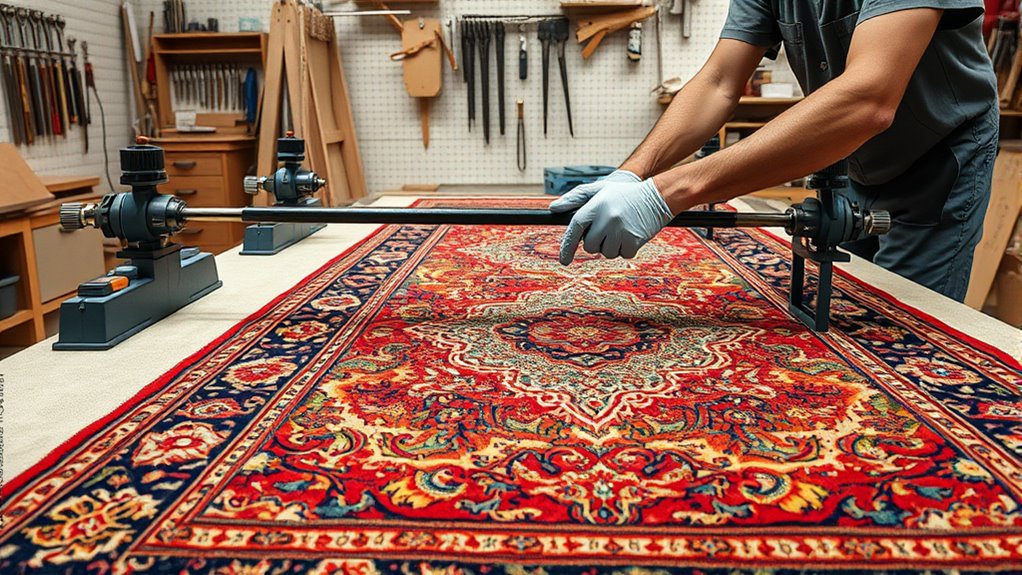
To achieve a smooth, well-stretched rug, choosing the right techniques and tools is essential. First, use a power stretcher or knee kicker to apply even tension across the rug, ensuring it stays taut. Second, employ a carpet or utility knife to trim excess edges, creating a clean fit. Finally, use a carpet stretching solution or adhesive for securing the edges and preventing future slack. These tools help you evenly distribute tension, avoid wrinkles, and create a professional finish. Proper technique involves anchoring the rug securely, pulling with steady, controlled force, and smoothing out wrinkles as you go. Additionally, understanding the importance of proper installation can help prevent the need for future stretching. With the right tools and methodical approach, you’ll achieve a perfectly stretched rug that enhances your space’s appearance and durability.
Risks of Ignoring Rug Stretching

Ignoring rug stretching can create trip hazards that could lead to injuries. It also increases the risk of damaging your carpet, which may result in costly repairs or replacements. Failing to address these issues early can end up costing you more in the long run. Regular maintenance, including proper rug stretching, helps preserve the integrity and safety of your flooring.
Increased Trip Hazards
When rugs are left unaddressed and start to loosen or curl, they create obvious trip hazards that can lead to falls and injuries. These loose edges or curled corners catch your foot unexpectedly, especially in busy areas or low lighting. Ignoring these issues increases the risk of slipping or stumbling, which can cause serious harm.
Here are three ways neglected rugs heighten hazards:
- Edges lift, making it easy to catch your foot.
- Curling corners create uneven walking surfaces.
- Loosened rugs shift underfoot, causing instability.
Carpet Damage Risk
Neglecting to properly stretch and secure your rugs can lead to significant carpet damage over time. Loose edges and wrinkles can cause uneven wear, tear, and even fiber fraying. This deterioration weakens the carpet’s structure, shortening its lifespan. Regular stretching prevents these issues by maintaining a tight, smooth surface. Ignoring this step allows dirt and debris to settle in folds, increasing abrasive damage. It also creates tripping hazards, risking further tears when caught on furniture or foot traffic. Here’s a quick overview:
| Damage Type | Cause | Result |
|---|---|---|
| Fiber Fraying | Loose edges, wrinkles | Shortened carpet lifespan |
| Uneven Wear | Frequent friction | Visible surface damage |
| Structural Weakness | Poor tension | Increased tearing |
Higher Replacement Costs
Failing to regularly stretch and secure your rug can lead to costly replacements. When a rug isn’t maintained, it becomes more prone to wrinkles, buckling, and uneven wear. These issues accelerate deterioration, forcing you to replace the entire rug sooner than expected. Additionally, neglecting proper care can create damage to the rug fibers, which further weakens its overall structure. Here’s what can happen if you ignore stretching:
- Damage to the rug fibers, weakening its structure.
- Increased tripping hazards, risking injuries.
- Higher costs due to premature replacement or extensive repairs.
Professional vs. DIY Rug Stretching: Which Is Better?
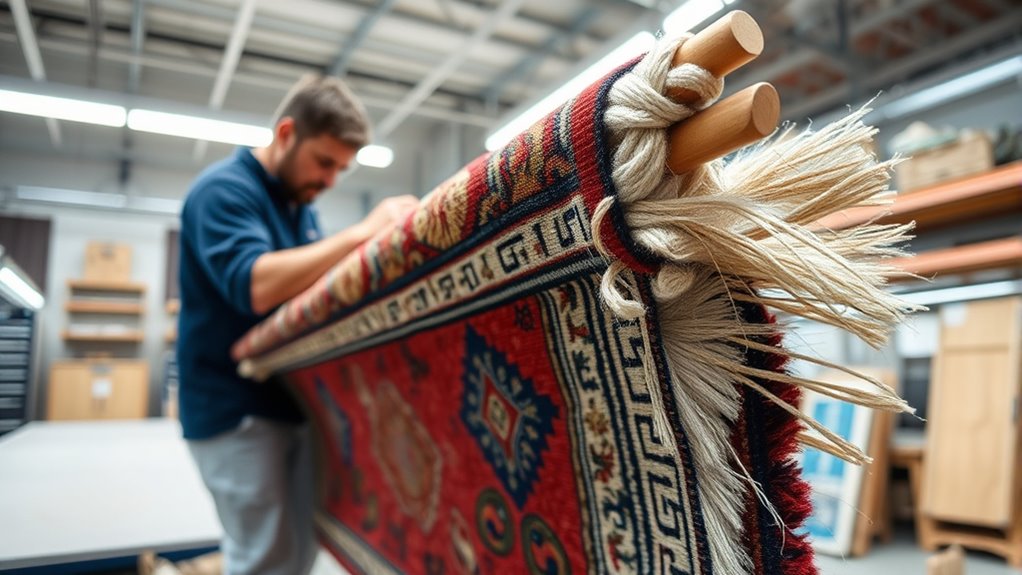
Deciding between professional and DIY rug stretching depends on your specific needs and skill level. If you’re handy and have the right tools, DIY can save you money and be satisfying. However, it requires patience, proper technique, and some physical effort. Mistakes can lead to uneven stretching or damage, which might cost more to fix later. Professional rug stretchers have experience, specialized equipment, and know-how to ensure a flawless job. They can handle stubborn wrinkles or significant stretching needs efficiently and with minimal risk. If your rug is delicate, valuable, or heavily wrinkled, hiring a pro is usually the safer option. Ultimately, consider your comfort with the task, your budget, and the rug’s condition before deciding which route to take. Additionally, understanding proper stretching techniques can help you determine whether a DIY approach is feasible for your situation.
Frequently Asked Questions
Can Rug Stretching Help Remove Stubborn Stains?
You might wonder if rug stretching can remove stubborn stains. While stretching helps improve your rug’s appearance by tightening loose fibers and realigning the pile, it doesn’t directly eliminate stains. To tackle stubborn marks, you should focus on proper cleaning methods like blotting, using stain removers, or professional cleaning. Stretching is a great maintenance step, but it’s not a solution for stain removal.
How Long Does the Rug Stretching Process Typically Take?
The rug stretching process usually takes between 30 minutes to a few hours, depending on the size and condition of your rug. You’ll want to allocate enough time for the stretching and drying, especially if you’re using professional equipment. Keep in mind that larger or heavily wrinkled rugs may take longer, but proper stretching can restore your rug’s appearance and prevent future damage.
Is Rug Stretching Safe for All Types of Carpets?
You might wonder if rug stretching is safe for all carpet types. Generally, it’s safe for most, especially when done correctly by a professional. However, delicate or antique carpets could be at risk of damage or fiber distortion. To protect your rug, consult a professional before stretching, especially if your carpet is fragile or valuable. They can assess your rug’s material and determine the safest approach.
What Are the Signs of Over-Stretching a Rug?
Think of your rug as a delicate dance partner. If you pull too hard, it strains and tears, losing its graceful flow. Signs of over-stretching include uneven edges, ripples, or a stretched appearance that looks unnatural. You might notice the fibers feeling brittle or the backing pulling away. If these signs appear, it’s a clear signal to stop stretching, or you risk damaging your beautiful carpet.
Will Stretching Damage the Rug’S Fibers or Backing?
Stretching your rug won’t damage the fibers or backing if you do it correctly. You should gently pull and stretch the rug, avoiding excessive force, to prevent tearing or weakening the materials. Proper technique helps relax wrinkles and restore shape without harm. If you’re unsure, consider consulting a professional to ensure you don’t accidentally cause damage, especially with delicate or antique rugs.
Conclusion
Just like a well-tuned instrument, your rug needs regular care to stay vibrant and resilient. Ignoring its signals is like letting a ship drift off course—eventually, you’ll face bigger problems. By staying attentive and knowing when to stretch, you ensure your space remains inviting and beautiful. Think of rug stretching as tending to a garden; with a little effort, you’ll keep it flourishing, brightening your home’s melody for years to come.
